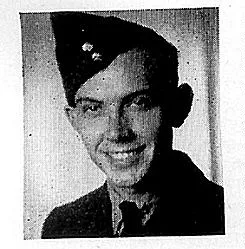23 Queen Street
Flight Officer William George Whitton

William Whitton was born in 1923 and lived in Paris at 23 Queen Street. He was the son of Mr. and Mrs. George Whitton. He completed his schooling in Paris and attended St. James Anglican Church. In 1940 he found employment at Scarfe and Company in Brantford. He enlisted in the Royal Canadian Air Force in September 1942.
He served first in No.433 Squadron, nicknamed the Porcupine Squadron, as a Flight Officer. He also became a member of the Caterpillar Club. The Caterpillar Club was an informal association of individuals who had successfully used a parachute to escape a disabled aircraft. Membership was awarded by parachute manufacturers to those whose lives were saved by their parachutes. The club’s name refers to the silk used in early parachutes, and members received a gold pin and certificate upon verification of their successful parachute jump from a disabled aircraft. Flight Officer Whitton was wounded and had been forced to bail out of his plane after a raid on Berlin on January 20 1944. He was a mid-upper gunner in a Halifax Bomber in the Bluenose Squadron. After reaching their target and releasing their bombload, they ran into a curtain of flak.
He was killed in action on his 20th bombing run on February 4, 1945 at the age of 22 when his Lancaster Bomber collided in flight with another bomber over Belgium, as airplanes were returning to base after bombing raids on Berlin, Germany. Mid-air crashes were rare but not uncommon as pilots tried to avoid anti-aircraft fire. William is buried near Vielsalm in Hotton War Cemetery in Belgium.
(Much of this information is found in the Canadian Virtual War Memorial created by Veterans Affairs Canada)
